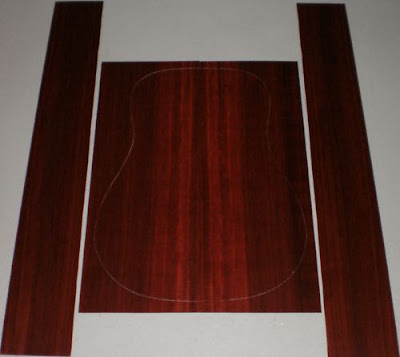Guitar Man
Guitar Wood:

Bocote
Cordia Gerascanthus
Bocote has a Rosewood-like taptone and features an attractive, tobacco/reddish brown color with distinct, parallel black lines (it does not show the spider-webbing figure that our best grade Ziricote does).
It comes from the same family as Ziricote (Cordia) and is found in the same region (Central America to Northern Amazon).
Less brittle than Ziricote, it is a popular wood with wood turners and has had success as a guitar tonewood, though few builders have created stock models from it yet.

East Indian Rosewood/Palisander
Dalbergia latifolia
Although East Indian Rosewood had been used for guitar backs and sides for many decades, it came into common usage starting in the mid-1960s when the more well known Brazilian Rosewood became less available in the quantities needed for large scale guitar production. High quality Indian Rosewood logs were plentiful and commercially available to the major markets when the Brazilian government stopped the export of Brazilian Rosewood logs. Fortunately, Indian Rosewood was also found to be an excellent alternative to Brazilian Rosewood both visually and tonally.
The color ranges from red to light brown with golden streaks, but more often runs to various shades of purple-brown (which eventually oxidizes to a rich brown color).
The workability of Indian Rosewood is very good. It is slightly less dense, more evenly grained and more stable than Brazilian Rosewood.
It bends well by hand or machine. The vast majority of the higher quality steel string and classical guitars made over the last thirty years have been made in Indian Rosewood. Even many of the top classical guitar makers - Romanillos, Fleta, Friederich, Gilbert - prefer it to Brazilian Rosewood.

Padauk
Pterocarpus soyauxii
Padauk is a bright orange or almost crimson wood when freshly cut, but oxidizes to a darker, rich purple-brown over time - although it stays redder than Indian Rosewood.
Slightly harder and heavier than Indian Rosewood it is a good back and side wood in all respects - stable, easy to work, with a strong tone.
Noted luthier Dana Bourgeois (Bourgeois Guitars) has said that, “Padauk is the most promising replacement for generic Rosewood”.
It may be a little difficult to bend compared to the ease of bending of some of the more pliable woods.
The lumber is readily available in larger planks, so the sets are moderately priced and exhibit good, straight grain throughout most pieces.

Pau Ferro / Morado
Machaerium villosum
Also known as Caviuna, Bolivian Rosewood, or Palo Santos, this Rosewood-like wood has many names and is often imported interchangeably with other similar species.
In appearance it’s much like Indian Rosewood, but substitute browns, golds and yellows for the purple shades.
A nonporous wood, it is a dream to finish, and has a nice tap tone. It’s heavier than Indian and Brazilian Rosewood; and it machines and glues well.

Wenge
Millettia laurentii
Wenge is a large straight growing tree found from central through western Africa.
It is abundant and should be commercially available for years to come.
In 1983 this wood was first suggested to us as a guitar tonewood by maker Don Musser.
In recent years as the price of Indian Rosewood has increased, Wenge has become a more viable alternative body wood.
The grain of the Wenge sets is tight and straight across the entire width of backs and sides.
The color is chocolate brown with evenly spaced black veins.
This wood is heavier than either Indian or Brazilian Rosewood and is stiffer, but softer, with large pores.
Any binding/trim scheme contrasts well with the even, consistent color and grain of this wood.

Zebrawood
Microberlina Brazzavillensis
Zebrawood has a more boldly colored alternative to Indian Rosewood.
With about the same density, workability and resonance as Indian Rosewood, it is evenly striped overall with small alternating bands of gold-tan and dark brown.
SOOOOOOOOOO..........
By now, I'm sure you're wondering what all this wood is for. Or maybe not, maybe you've figured it all out by now.
My new thing for this year is guitars........I'm gonna help build them. Or at least give it a whack!!
My fraternity brother Mark Hodges has a big brother named Mike that can do anything - and some of his anything happens to be that he is a luthier.
Cool name for someone who repairs and builds guitars.
He's got the shop, the time, the energy and the talent.
So what am I bringing to the table you may ask?
I am bringing the stuff and the vision and the BUSINESS PLAN!!
Handmade guitars bring lots of money!!
So if you have an extra $3000 laying around, I will build you (or better said: I will get you one built and rub on it when he lets me)!
I have procured 6 sets of wood for 6 guitars. You may have notice the pictures of it above!
Shopping for this stuff has been so much fun for me because I have literally talked to folks all over the world, made some connections and formed some relationships.
Because of that, I have gotten the wood at a great price.
I have less money in the wood than I do in my last guitar so even if the two I've already presold fall through, I still get me a couple of great handmade guitars at a very small price.
Oh I love this stuff!!
I haven't decided which wood I'm going to choose for my first guitar but I'm leaning heavily towards the zebrawood because it's so cool!! And yes, those pictures above are of the actual wood I have - not shined up encyclopedia pictures!!
I'll post pictures as we go along this journey and let you know how it goes.

Bocote
Cordia Gerascanthus
Bocote has a Rosewood-like taptone and features an attractive, tobacco/reddish brown color with distinct, parallel black lines (it does not show the spider-webbing figure that our best grade Ziricote does).
It comes from the same family as Ziricote (Cordia) and is found in the same region (Central America to Northern Amazon).
Less brittle than Ziricote, it is a popular wood with wood turners and has had success as a guitar tonewood, though few builders have created stock models from it yet.

East Indian Rosewood/Palisander
Dalbergia latifolia
Although East Indian Rosewood had been used for guitar backs and sides for many decades, it came into common usage starting in the mid-1960s when the more well known Brazilian Rosewood became less available in the quantities needed for large scale guitar production. High quality Indian Rosewood logs were plentiful and commercially available to the major markets when the Brazilian government stopped the export of Brazilian Rosewood logs. Fortunately, Indian Rosewood was also found to be an excellent alternative to Brazilian Rosewood both visually and tonally.
The color ranges from red to light brown with golden streaks, but more often runs to various shades of purple-brown (which eventually oxidizes to a rich brown color).
The workability of Indian Rosewood is very good. It is slightly less dense, more evenly grained and more stable than Brazilian Rosewood.
It bends well by hand or machine. The vast majority of the higher quality steel string and classical guitars made over the last thirty years have been made in Indian Rosewood. Even many of the top classical guitar makers - Romanillos, Fleta, Friederich, Gilbert - prefer it to Brazilian Rosewood.

Padauk
Pterocarpus soyauxii
Padauk is a bright orange or almost crimson wood when freshly cut, but oxidizes to a darker, rich purple-brown over time - although it stays redder than Indian Rosewood.
Slightly harder and heavier than Indian Rosewood it is a good back and side wood in all respects - stable, easy to work, with a strong tone.
Noted luthier Dana Bourgeois (Bourgeois Guitars) has said that, “Padauk is the most promising replacement for generic Rosewood”.
It may be a little difficult to bend compared to the ease of bending of some of the more pliable woods.
The lumber is readily available in larger planks, so the sets are moderately priced and exhibit good, straight grain throughout most pieces.

Pau Ferro / Morado
Machaerium villosum
Also known as Caviuna, Bolivian Rosewood, or Palo Santos, this Rosewood-like wood has many names and is often imported interchangeably with other similar species.
In appearance it’s much like Indian Rosewood, but substitute browns, golds and yellows for the purple shades.
A nonporous wood, it is a dream to finish, and has a nice tap tone. It’s heavier than Indian and Brazilian Rosewood; and it machines and glues well.

Wenge
Millettia laurentii
Wenge is a large straight growing tree found from central through western Africa.
It is abundant and should be commercially available for years to come.
In 1983 this wood was first suggested to us as a guitar tonewood by maker Don Musser.
In recent years as the price of Indian Rosewood has increased, Wenge has become a more viable alternative body wood.
The grain of the Wenge sets is tight and straight across the entire width of backs and sides.
The color is chocolate brown with evenly spaced black veins.
This wood is heavier than either Indian or Brazilian Rosewood and is stiffer, but softer, with large pores.
Any binding/trim scheme contrasts well with the even, consistent color and grain of this wood.

Zebrawood
Microberlina Brazzavillensis
Zebrawood has a more boldly colored alternative to Indian Rosewood.
With about the same density, workability and resonance as Indian Rosewood, it is evenly striped overall with small alternating bands of gold-tan and dark brown.
SOOOOOOOOOO..........
By now, I'm sure you're wondering what all this wood is for. Or maybe not, maybe you've figured it all out by now.
My new thing for this year is guitars........I'm gonna help build them. Or at least give it a whack!!
My fraternity brother Mark Hodges has a big brother named Mike that can do anything - and some of his anything happens to be that he is a luthier.
Cool name for someone who repairs and builds guitars.
He's got the shop, the time, the energy and the talent.
So what am I bringing to the table you may ask?
I am bringing the stuff and the vision and the BUSINESS PLAN!!
Handmade guitars bring lots of money!!
So if you have an extra $3000 laying around, I will build you (or better said: I will get you one built and rub on it when he lets me)!
I have procured 6 sets of wood for 6 guitars. You may have notice the pictures of it above!
Shopping for this stuff has been so much fun for me because I have literally talked to folks all over the world, made some connections and formed some relationships.
Because of that, I have gotten the wood at a great price.
I have less money in the wood than I do in my last guitar so even if the two I've already presold fall through, I still get me a couple of great handmade guitars at a very small price.
Oh I love this stuff!!
I haven't decided which wood I'm going to choose for my first guitar but I'm leaning heavily towards the zebrawood because it's so cool!! And yes, those pictures above are of the actual wood I have - not shined up encyclopedia pictures!!
I'll post pictures as we go along this journey and let you know how it goes.

